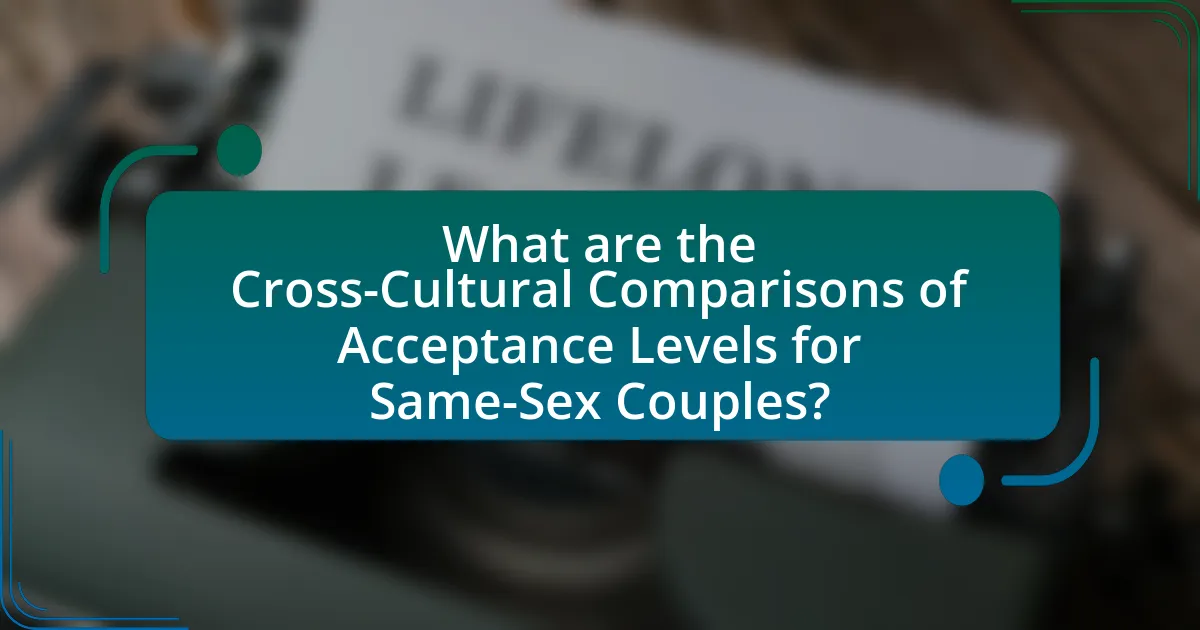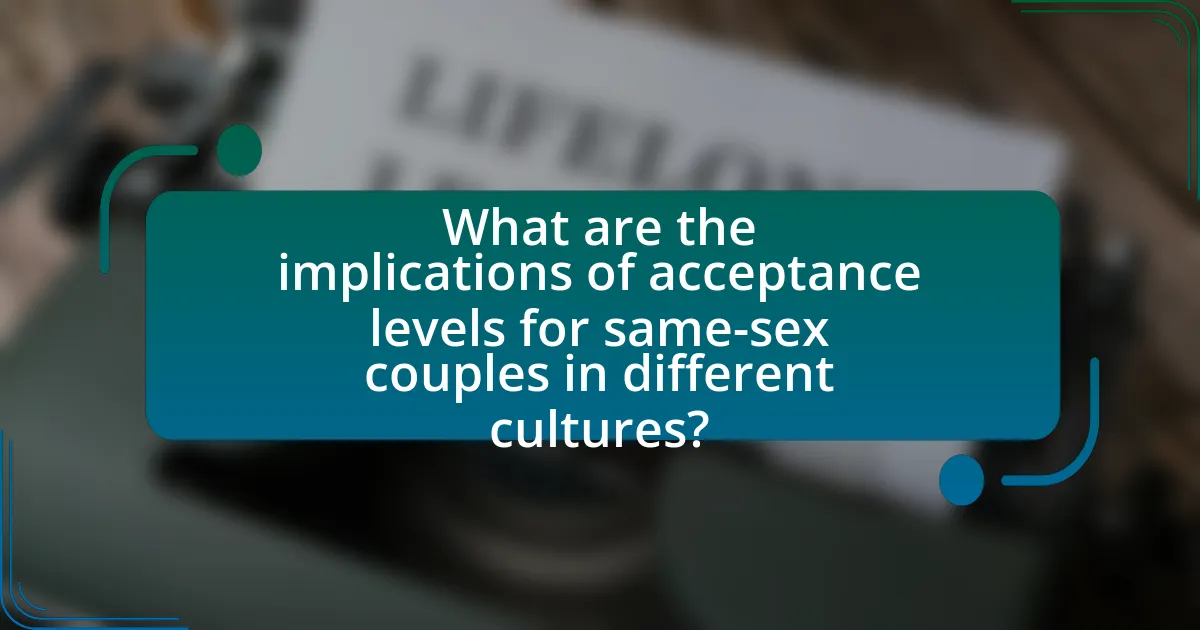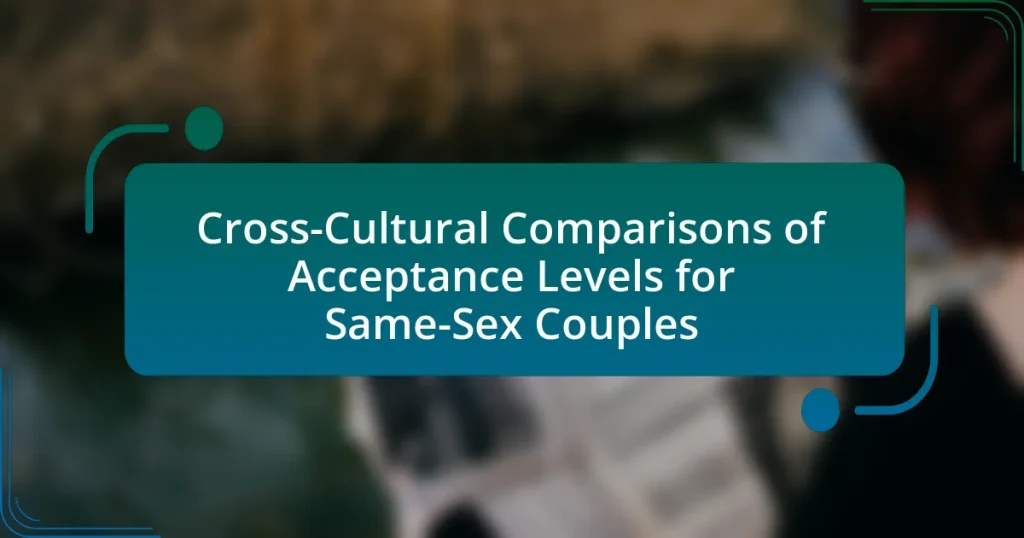The article examines cross-cultural comparisons of acceptance levels for same-sex couples, highlighting significant variations influenced by cultural, religious, and legal factors. It presents data showing high acceptance rates in countries like Canada and the Netherlands, contrasted with low acceptance in nations such as Uganda and Russia. The discussion includes how historical, religious, and social factors shape perceptions of same-sex relationships, the impact of legal rights on societal acceptance, and the role of media representation. Additionally, it explores generational differences, the implications of acceptance for LGBTQ+ rights, and strategies to promote inclusivity in less accepting cultures.

What are the Cross-Cultural Comparisons of Acceptance Levels for Same-Sex Couples?
Cross-cultural comparisons of acceptance levels for same-sex couples reveal significant variations influenced by cultural, religious, and legal factors. For instance, countries like Canada and the Netherlands exhibit high acceptance rates, with surveys indicating over 80% support for same-sex marriage, while nations such as Uganda and Russia show stark opposition, with acceptance levels below 10%. Research by the Pew Research Center in 2020 highlighted that acceptance is often correlated with factors such as education, urbanization, and exposure to diverse lifestyles, demonstrating that more progressive societies tend to embrace same-sex relationships more readily.
How do different cultures perceive same-sex relationships?
Different cultures perceive same-sex relationships with varying degrees of acceptance, influenced by historical, religious, and social factors. For instance, in Western cultures such as the United States and many European nations, there has been a significant shift towards acceptance, with legal recognition of same-sex marriage and anti-discrimination laws established in recent decades. Conversely, in many Middle Eastern and African cultures, same-sex relationships are often stigmatized and can be subject to legal penalties, reflecting deeply rooted religious beliefs and traditional norms. A 2020 Pew Research Center study indicated that acceptance levels for same-sex relationships vary widely, with 72% of adults in Spain supporting same-sex marriage compared to only 5% in countries like Nigeria. This illustrates the stark contrast in cultural perceptions and legal frameworks surrounding same-sex relationships globally.
What historical factors influence cultural attitudes towards same-sex couples?
Historical factors that influence cultural attitudes towards same-sex couples include religious beliefs, legal frameworks, and social movements. For instance, many cultures have historically viewed homosexuality through a religious lens, often condemning it based on doctrines that promote heterosexual relationships as the norm. Legal frameworks, such as laws criminalizing same-sex relationships, have also shaped societal views, reinforcing stigma and discrimination. Additionally, social movements advocating for LGBTQ+ rights, particularly since the late 20th century, have gradually shifted public perception, leading to increased acceptance in various regions. For example, the Stonewall Riots in 1969 marked a significant turning point in the fight for LGBTQ+ rights in the United States, influencing attitudes globally.
How do religious beliefs shape acceptance levels in various cultures?
Religious beliefs significantly influence acceptance levels of same-sex couples across various cultures. In cultures where conservative religious doctrines prevail, such as in many Islamic and Christian communities, acceptance of same-sex relationships tends to be low due to teachings that view homosexuality as morally unacceptable. For instance, a Pew Research Center study from 2020 found that in predominantly Muslim countries, over 80% of respondents opposed same-sex relationships, reflecting the strong impact of religious beliefs on societal norms. Conversely, cultures with more liberal religious interpretations or secular beliefs, such as in parts of Western Europe, show higher acceptance levels, with countries like the Netherlands and Sweden reporting over 80% support for same-sex marriage. This disparity illustrates how religious frameworks can either hinder or promote acceptance, shaping societal attitudes toward same-sex couples.
What are the key indicators of acceptance for same-sex couples across cultures?
Key indicators of acceptance for same-sex couples across cultures include legal recognition, social attitudes, and representation in media. Legal recognition, such as marriage equality and anti-discrimination laws, significantly correlates with societal acceptance; for instance, countries like Canada and the Netherlands, which have legalized same-sex marriage, show higher acceptance levels. Social attitudes can be measured through surveys indicating public support for same-sex relationships; research from the Pew Research Center reveals that acceptance varies widely, with Western nations generally exhibiting more favorable views compared to many regions in Africa and the Middle East. Additionally, positive representation of same-sex couples in media influences public perception, as seen in countries where LGBTQ+ characters are prominently featured in television and film, leading to increased acceptance.
How do legal rights impact societal acceptance of same-sex couples?
Legal rights significantly enhance societal acceptance of same-sex couples by providing them with equal recognition and protection under the law. When same-sex couples gain legal rights, such as marriage equality and anti-discrimination protections, it fosters a more inclusive environment, leading to increased visibility and normalization of their relationships. Research indicates that countries with legal recognition of same-sex relationships, like the Netherlands and Canada, show higher levels of societal acceptance compared to those without such rights. For instance, a study published in the Journal of Homosexuality found that legal marriage for same-sex couples correlates with a 10% increase in public support for same-sex relationships. This demonstrates that legal rights not only validate the existence of same-sex couples but also influence public attitudes, promoting greater acceptance within society.
What role does media representation play in shaping public opinion?
Media representation significantly influences public opinion by framing narratives and shaping perceptions about various social issues, including the acceptance of same-sex couples. Research indicates that positive portrayals of same-sex relationships in media can lead to increased acceptance and support among audiences. For instance, a study published in the Journal of Homosexuality found that exposure to positive media representations of LGBTQ+ individuals correlates with more favorable attitudes towards same-sex marriage. This demonstrates that media not only reflects societal attitudes but also actively contributes to their evolution by normalizing diverse identities and relationships.
Why is it important to study cross-cultural acceptance of same-sex couples?
Studying cross-cultural acceptance of same-sex couples is important because it reveals how societal norms and values influence attitudes towards sexual orientation. Understanding these differences can inform policies and practices that promote equality and reduce discrimination. For instance, research by the Pew Research Center in 2020 indicated that acceptance levels vary significantly across countries, with 73% of people in the Netherlands supporting same-sex marriage compared to only 5% in countries like Nigeria. This data highlights the necessity of examining cultural contexts to foster inclusivity and address the unique challenges faced by same-sex couples globally.
What implications does acceptance have for LGBTQ+ rights globally?
Acceptance significantly enhances LGBTQ+ rights globally by fostering legal protections and social recognition. When societies embrace LGBTQ+ individuals, they are more likely to implement anti-discrimination laws, recognize same-sex marriages, and promote inclusive policies. For instance, countries with higher acceptance levels, such as Canada and the Netherlands, have established comprehensive legal frameworks that protect LGBTQ+ rights, resulting in improved mental health outcomes and social integration for LGBTQ+ individuals. Conversely, regions with low acceptance often experience increased violence and discrimination against LGBTQ+ communities, highlighting the direct correlation between societal acceptance and the advancement of rights.
How can understanding cultural differences improve advocacy efforts?
Understanding cultural differences can significantly enhance advocacy efforts by tailoring messages and strategies to resonate with diverse audiences. When advocates recognize the unique values, beliefs, and social norms of different cultures, they can create more effective communication that aligns with those cultural contexts. For instance, research indicates that advocacy campaigns addressing same-sex couple acceptance must consider local attitudes and legal frameworks, as seen in studies comparing acceptance levels across countries like the United States and Brazil, where cultural attitudes towards LGBTQ+ rights vary widely. By adapting advocacy approaches to reflect these cultural nuances, advocates can foster greater empathy and support, ultimately leading to more successful outcomes in promoting acceptance and equality for same-sex couples.

What are the major cultural differences in acceptance levels for same-sex couples?
Major cultural differences in acceptance levels for same-sex couples exist primarily between Western and non-Western societies. In many Western countries, such as Canada and the Netherlands, acceptance is high, with legal recognition of same-sex marriage and widespread societal support, evidenced by surveys indicating over 70% approval rates for same-sex marriage. Conversely, in many non-Western cultures, particularly in parts of Africa and the Middle East, acceptance is significantly lower, with legal penalties for same-sex relationships and societal stigma prevalent, as shown by reports from organizations like ILGA (International Lesbian, Gay, Bisexual, Trans and Intersex Association) which highlight that over 70 countries still criminalize same-sex relationships. These cultural attitudes are influenced by factors such as religion, tradition, and social norms, leading to stark contrasts in acceptance levels globally.
Which countries are most accepting of same-sex couples?
Countries most accepting of same-sex couples include Canada, the Netherlands, and Sweden. These nations have implemented comprehensive legal protections for LGBTQ+ rights, including marriage equality and anti-discrimination laws. For instance, Canada legalized same-sex marriage in 2005, becoming one of the first countries to do so, while the Netherlands was the first in the world to legalize it in 2001. Sweden also recognizes same-sex marriage and has strong anti-discrimination protections in place. These legal frameworks reflect a broader societal acceptance, as evidenced by high approval ratings for same-sex relationships in public opinion surveys conducted in these countries.
What social policies contribute to higher acceptance in these countries?
Social policies that contribute to higher acceptance of same-sex couples in various countries include anti-discrimination laws, marriage equality legislation, and comprehensive sex education. Anti-discrimination laws protect individuals from bias based on sexual orientation, fostering an inclusive environment. Countries like Canada and the Netherlands have implemented such laws, resulting in increased societal acceptance, as evidenced by surveys indicating higher support for LGBTQ+ rights. Marriage equality legislation, as seen in countries like Spain and Germany, not only legitimizes same-sex relationships but also normalizes them within society, leading to greater acceptance. Additionally, comprehensive sex education that includes LGBTQ+ topics promotes understanding and reduces stigma, contributing to a more accepting culture. Research shows that countries with inclusive educational policies report higher levels of acceptance among younger populations.
How do public attitudes vary within these accepting countries?
Public attitudes towards same-sex couples vary significantly within accepting countries, influenced by factors such as region, age, and cultural background. For instance, in countries like Canada and the Netherlands, urban areas tend to show higher acceptance levels compared to rural regions, where traditional values may prevail. Additionally, younger demographics generally exhibit more progressive views on same-sex relationships than older generations, reflecting a shift in societal norms over time. Research from the Pew Research Center indicates that acceptance rates can differ by as much as 30 percentage points between different regions within the same country, highlighting the complexity of public attitudes even in broadly accepting societies.
What cultures exhibit lower acceptance levels for same-sex couples?
Cultures in regions such as the Middle East, parts of Africa, and some Asian countries exhibit lower acceptance levels for same-sex couples. For instance, countries like Saudi Arabia and Iran enforce strict laws against homosexuality, often resulting in severe penalties, including imprisonment or even death. In Africa, nations such as Uganda and Nigeria have implemented anti-LGBTQ+ legislation, reflecting widespread societal disapproval. Additionally, in countries like Indonesia, conservative Islamic values contribute to a cultural environment that is largely intolerant of same-sex relationships. These examples illustrate the significant cultural and legal barriers faced by same-sex couples in these regions.
What are the common reasons for resistance in these cultures?
Common reasons for resistance in cultures regarding same-sex couples include deeply rooted traditional beliefs, religious doctrines, and societal norms that prioritize heterosexual relationships. These factors often create a framework where non-heteronormative identities are viewed as deviant or unacceptable. For instance, in many cultures, religious teachings explicitly condemn homosexuality, leading to widespread stigma and discrimination. Additionally, cultural narratives that emphasize family lineage and procreation further marginalize same-sex relationships, as they do not conform to these expectations. Research indicates that in regions with strong collectivist values, such as parts of Asia and Africa, the pressure to conform to community standards can intensify resistance to same-sex couples, as individual identities are often subordinated to group cohesion.
How do societal norms and values affect acceptance in these regions?
Societal norms and values significantly influence acceptance levels for same-sex couples in various regions. In cultures where traditional family structures and heterosexual relationships are prioritized, acceptance tends to be lower, as seen in many conservative societies where religious beliefs dictate social attitudes. Conversely, regions that embrace progressive values and prioritize individual rights often exhibit higher acceptance levels, as evidenced by countries like Canada and the Netherlands, where legal recognition of same-sex relationships correlates with broader societal acceptance. Research indicates that in societies with strong egalitarian values, such as those in Scandinavia, acceptance of same-sex couples is markedly higher, reflecting a direct relationship between societal values and the level of acceptance.
How do generational differences impact acceptance levels?
Generational differences significantly impact acceptance levels of same-sex couples, with younger generations generally exhibiting higher acceptance compared to older generations. Research indicates that individuals born after the 1980s are more likely to support same-sex marriage and LGBTQ+ rights, reflecting broader societal changes and increased visibility of LGBTQ+ issues. For instance, a 2020 Pew Research Center study found that 70% of Millennials and Generation Z support same-sex marriage, while only 40% of Baby Boomers and 30% of the Silent Generation share this view. This disparity highlights how cultural shifts, influenced by factors such as education, media representation, and social movements, contribute to varying acceptance levels across generations.
What trends are observed among younger versus older generations?
Younger generations exhibit significantly higher acceptance levels for same-sex couples compared to older generations. Research indicates that 70% of millennials support same-sex marriage, while only 40% of baby boomers share this view. This trend reflects broader societal shifts, with younger individuals often prioritizing values of equality and inclusivity, influenced by increased visibility of LGBTQ+ issues in media and education. Additionally, studies show that younger people are more likely to identify as allies and advocate for LGBTQ+ rights, further highlighting the generational divide in attitudes toward same-sex couples.
How does education level correlate with acceptance of same-sex couples?
Higher education levels correlate positively with greater acceptance of same-sex couples. Research indicates that individuals with higher educational attainment tend to hold more progressive views on social issues, including LGBTQ+ rights. For instance, a study published in the “Journal of Homosexuality” found that college-educated individuals are significantly more likely to support same-sex marriage compared to those with only a high school education. This trend is consistent across various cultures, suggesting that education fosters critical thinking and exposure to diverse perspectives, which in turn enhances acceptance of same-sex couples.

What are the implications of acceptance levels for same-sex couples in different cultures?
Acceptance levels for same-sex couples in different cultures significantly impact their social, legal, and psychological well-being. In cultures with high acceptance, same-sex couples often experience legal recognition, social support, and reduced discrimination, leading to better mental health outcomes and a sense of belonging. For instance, countries like Canada and the Netherlands, which have legalized same-sex marriage, report lower rates of mental health issues among LGBTQ+ individuals compared to countries with restrictive laws. Conversely, in cultures with low acceptance, such as in parts of Africa and the Middle East, same-sex couples face legal penalties, social ostracism, and increased mental health challenges, as evidenced by studies indicating higher rates of depression and anxiety in these populations. Thus, the level of acceptance directly correlates with the quality of life and societal integration for same-sex couples across different cultural contexts.
How does acceptance influence the mental health of LGBTQ+ individuals?
Acceptance significantly improves the mental health of LGBTQ+ individuals by reducing feelings of isolation and increasing self-esteem. Research indicates that higher levels of acceptance correlate with lower rates of depression and anxiety among LGBTQ+ populations. For instance, a study published in the American Journal of Public Health found that LGBTQ+ individuals who reported higher acceptance from family and peers experienced significantly better mental health outcomes, including lower suicidal ideation rates. This evidence underscores the critical role that acceptance plays in fostering a supportive environment, which is essential for the psychological well-being of LGBTQ+ individuals.
What are the psychological effects of living in a non-accepting culture?
Living in a non-accepting culture can lead to significant psychological effects, including increased levels of anxiety, depression, and low self-esteem. Individuals often experience feelings of isolation and alienation due to societal rejection, which can exacerbate mental health issues. Research indicates that marginalized groups, such as LGBTQ+ individuals, face higher rates of mental health disorders in non-accepting environments; for instance, a study published in the American Journal of Public Health found that LGBTQ+ youth in non-accepting cultures are more likely to report suicidal ideation compared to their peers in accepting cultures. This lack of acceptance can hinder personal development and lead to internalized stigma, further impacting overall well-being.
How can acceptance improve overall community well-being?
Acceptance can significantly improve overall community well-being by fostering inclusivity and reducing social tensions. When communities embrace acceptance, individuals feel valued and supported, leading to enhanced mental health outcomes and lower rates of discrimination. Research indicates that inclusive environments contribute to higher levels of social cohesion and trust among community members, which are essential for collective well-being. For instance, a study published in the Journal of Community Psychology found that communities with higher acceptance levels of diverse groups, including same-sex couples, reported greater overall life satisfaction and lower incidences of mental health issues. This evidence underscores the positive impact of acceptance on community dynamics and individual well-being.
What strategies can be employed to promote acceptance in less accepting cultures?
To promote acceptance in less accepting cultures, education and awareness campaigns can be employed effectively. These initiatives can include workshops, seminars, and community discussions that focus on the importance of diversity and inclusion, highlighting the positive contributions of same-sex couples to society. Research indicates that exposure to diverse perspectives can reduce prejudice; for instance, a study published in the Journal of Social Issues found that individuals who participated in educational programs about LGBTQ+ issues showed increased acceptance and understanding. Additionally, leveraging influential community leaders to advocate for acceptance can help shift cultural norms, as their endorsement can lend credibility to the message.
What role do education and awareness campaigns play in fostering acceptance?
Education and awareness campaigns play a crucial role in fostering acceptance by providing accurate information and challenging stereotypes about same-sex couples. These campaigns educate the public on LGBTQ+ issues, promoting understanding and empathy, which are essential for reducing prejudice. For instance, studies have shown that communities exposed to educational initiatives regarding LGBTQ+ rights experience a significant increase in acceptance levels, as evidenced by a 2019 report from the Williams Institute, which found that states with comprehensive sex education that includes LGBTQ+ topics report higher acceptance rates. Thus, education and awareness campaigns are instrumental in transforming societal attitudes and fostering a more inclusive environment for same-sex couples.
How can international organizations support LGBTQ+ rights in various cultures?
International organizations can support LGBTQ+ rights in various cultures by promoting inclusive policies, providing resources for advocacy, and facilitating dialogue among stakeholders. For instance, organizations like the United Nations have established frameworks such as the Yogyakarta Principles, which outline international human rights standards related to sexual orientation and gender identity. These principles serve as a guide for countries to align their laws with global human rights norms. Additionally, international organizations can offer funding and training to local LGBTQ+ groups, enabling them to effectively advocate for their rights within their cultural contexts. Evidence of this approach’s effectiveness can be seen in countries where international support has led to legislative changes, such as the decriminalization of homosexuality in several nations following advocacy campaigns backed by global entities.
What best practices can be adopted to enhance acceptance levels for same-sex couples?
To enhance acceptance levels for same-sex couples, implementing comprehensive educational programs that promote understanding and empathy is essential. These programs should focus on LGBTQ+ history, rights, and the challenges faced by same-sex couples, fostering a more informed and compassionate society. Research indicates that exposure to diverse sexual orientations through inclusive curricula can significantly reduce prejudice; for instance, a study published in the Journal of Homosexuality found that students who participated in LGBTQ+ education reported higher levels of acceptance and lower levels of homophobia. Additionally, promoting visibility through media representation and community events can normalize same-sex relationships, further contributing to societal acceptance.
How can local communities engage in dialogue to promote understanding?
Local communities can engage in dialogue to promote understanding by organizing inclusive forums and workshops that encourage open discussions about diverse perspectives, particularly regarding acceptance of same-sex couples. These forums can facilitate direct communication among community members, allowing individuals to share personal experiences and cultural viewpoints. Research indicates that structured dialogues can reduce prejudice and foster empathy, as seen in studies like “The Impact of Dialogue on Attitudes Toward Same-Sex Couples” published in the Journal of Social Issues, which found that participants who engaged in dialogue reported increased acceptance levels. By creating safe spaces for conversation, local communities can effectively bridge gaps in understanding and promote a more inclusive environment.
What resources are available for advocacy and support in different cultural contexts?
Resources for advocacy and support in different cultural contexts include local LGBTQ+ organizations, international human rights groups, and culturally specific community centers. Local LGBTQ+ organizations often provide tailored support and advocacy efforts that resonate with the cultural values and norms of the community, such as the Human Rights Campaign in the United States or ILGA (International Lesbian, Gay, Bisexual, Trans and Intersex Association) globally. International human rights groups like Amnesty International and Human Rights Watch offer resources and reports that highlight the status of LGBTQ+ rights across various cultures, providing a broader context for advocacy. Additionally, culturally specific community centers can offer safe spaces and resources that reflect the unique challenges faced by LGBTQ+ individuals within their cultural settings, fostering acceptance and support.


